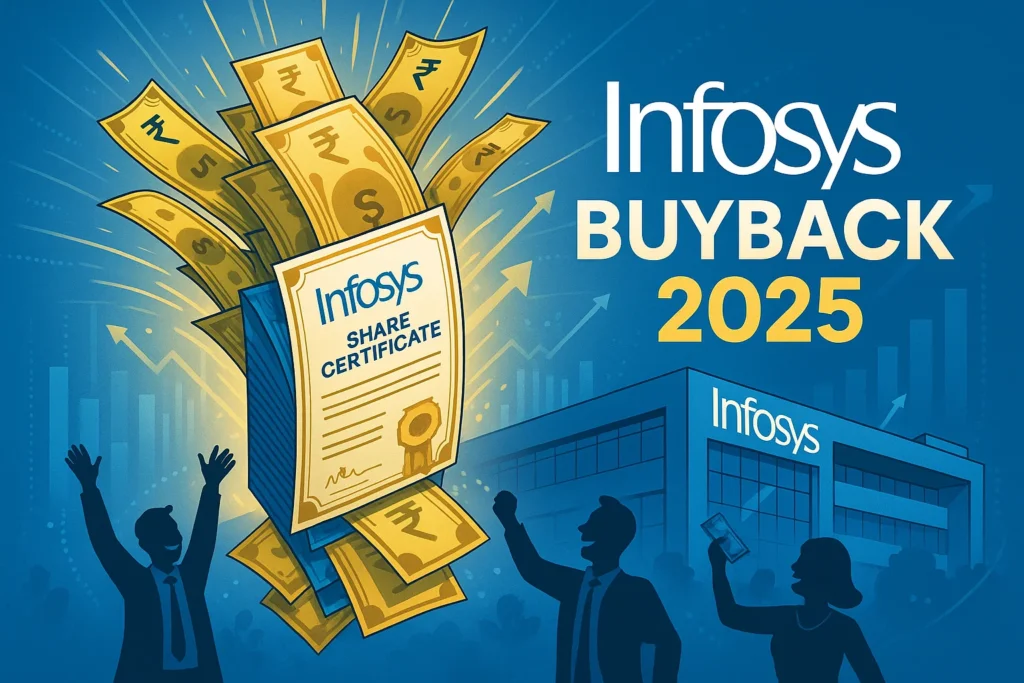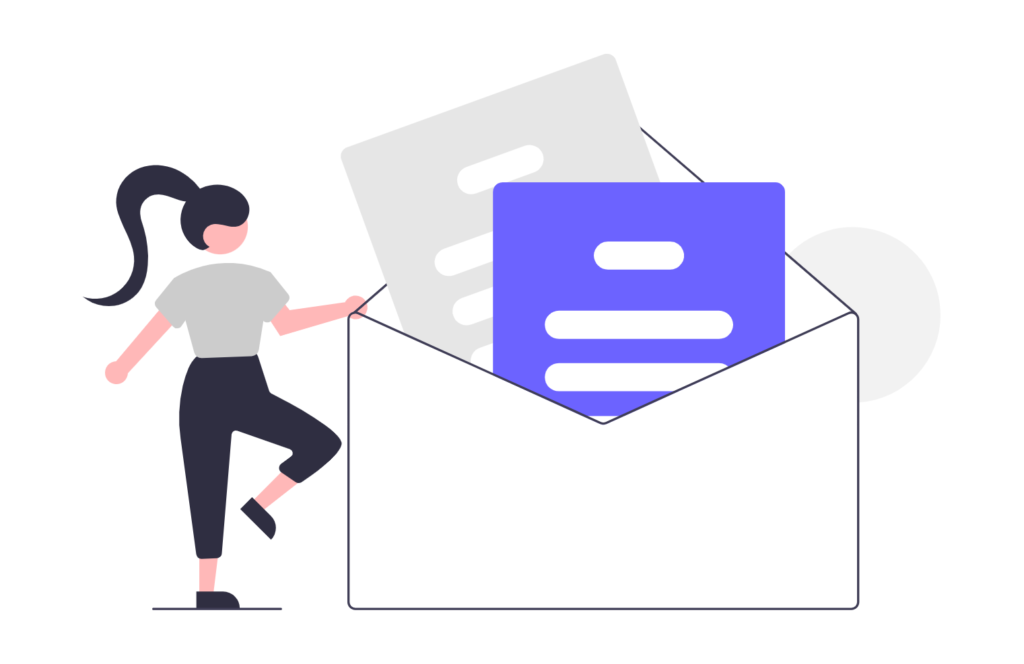India’s IT industry has always played big. But 2025 is special. Infosys, the second largest IT company, is launching its largest ever buyback. The Infosys Buyback this year has put the entire stock market on alert. Why? Because the numbers, the timing, and the structure are all designed to generate maximum shareholder value.
This guide will walk you through every detail of Infosys Buyback. We’ll explain why it matters, how to participate, who wins, and what analysts say. Short sentences. Clear points. All data up to November 19, 2025.
What is Infosys Buyback?
Infosys Buyback is a share repurchase scheme. Infosys will buy back its own shares from eligible investors. Share buyback reduces the number of shares in the market. It often boosts the value of remaining shares. Infosys started this program in September 2025.
This buyback is worth ₹18,000 crore. That is the highest ever for Infosys. The tender offer opens November 20, and closes November 26. The buyback price is ₹1,800 per share. This is a 17–19% premium over the market price around the announcement.
Only shareholders on record as of November 14, 2025, are eligible to participate. If you bought Infosys shares after this date, you must wait for the next buyback.
A Quick Reference Table: Key Infosys Buyback 2025 Data
| Feature | Detail | Impact |
|---|---|---|
| Amount | ₹18,000 Crore | Largest ever Infosys buyback |
| Price per share | ₹1,800 | Substantial premium offered |
| Shares repurchased | 10 Crore | 2.41% of total equity |
| Record date | November 14, 2025 | Determines eligibility |
| Window dates | Nov 20–Nov 26, 2025 | Only seven days to tender |
| Payment start | December 3, 2025 | Quick settlement |
| Promoter participation | None | More room for public shareholders |
| Small shareholder reserve | 15% of buyback (under ₹2 lakh holding) | Higher acceptance ratio for retail |
| Acceptance Ratio Estimate | Retail: 5–25%; General: 2–3% | Might vary based on participation |
| Tax Treatment | Deemed dividend (slab rate) | Large impact for high-income investors |
| Capital policy | 85% free cash flow returned as payout | Shows dividend-buyback balance |
Deep Dive: Why Infosys Buyback Is Making Headlines
Infosys has run buybacks before. But this new Infosys Buyback breaks several records. Let’s look at what sets it apart.
- Biggest buyback ever. The ₹18,000 crore figure even beats some past IT buybacks by TCS.
- Premium price. ₹1,800 per share is much higher than Infosys’s recent trading prices. That’s a quick gain opportunity for those looking to exit.
- Promoters not in play. The Infosys founders and top insiders have chosen not to participate. This is rare. Most buybacks see at least some promoter involvement. Their choice increases available shares for public investors.
- Short window period. Only seven days to act. From November 20 to 26, you must log into your broker account and tender shares. Miss it, miss the payout.
Infosys’s Buyback announcement created a buzz. The market responded quickly. Infosys shares jumped over 3% in a single day after the buyback window dates were announced. That’s a signal of positive sentiment.
Check Buyback all details Here
Who Can Participate in Infosys Buyback?
Eligibility matters. Only those who held Infosys shares on November 14, 2025, qualify. If you held shares in your demat account or as physical certificates, you can join the Infosys Buyback.
There are two participation buckets:
- Small Shareholders: Those holding shares worth less than ₹2 lakh in value.
- General Category: Those with larger holdings.
Infosys has allotted 15% of the buyback pool to small shareholders. This improves odds for retail investors. Small shareholders might get about 2 shares accepted for every 11 held. In the general category, the ratio is tougher – around 17 accepted for every 706 held.
But these are just “entitlements.” Final acceptance depends on how many eligible investors tender. If more people participate, ratios can shrink. If fewer, ratios go up.
How To Actually Tender Shares in Infosys Buyback
Participating is simple for most. If you have a demat account, log in and look for “corporate actions” or “buyback offers.” There will be an option named Infosys Buyback. Enter the number of shares you want to tender. Usually, brokers send email alerts if you qualify.
Physical shareholders need to submit forms to Infosys’s registrar, KFin Technologies. You must submit original share certificates, the official tender form SH-4, and identification documents before the deadline.
Infosys will settle payments by December 3, 2025. Extinguishment of shares happens by December 12, 2025. That is, your shares will be cancelled, reducing Infosys’s outstanding equity base.
Infosys Buyback – The Tax Angle
Tax is a big factor. Before October 2024, buybacks were taxed at 20% for long-term capital gains. Now, buyback payments are “deemed dividend.” That means your entire payout is taxed according to your income slab.
If you tender 500 shares purchased at ₹900 and Infosys buys back at ₹1,800, you get ₹9,00,000. If you’re in the 30% tax bracket, you pay ₹2,70,000 as tax. The cost of acquisition – ₹4,50,000 – can be considered a capital loss, offsetting gains elsewhere. You might save some tax this way, but the net gain reduces.
For most investors, especially in higher tax brackets, the effective return from Infosys Buyback shrinks. However, those in lower tax brackets or with strategic loss harvesting can still make solid gains.
History of Infosys Buybacks
Infosys has conducted buybacks regularly:
- 2017 Buyback: ₹13,000 crore at ₹1,150 per share.
- 2019 Buyback: ₹8,260 crore at ₹747 per share (open market route).
- 2021 Buyback: ₹9,200 crore at ₹1,750 per share.
- 2022-23 Buyback: ₹9,300 crore at ₹1,850 per share.
Each buyback offered a premium. Post-buyback periods saw the stock climb 9–22% over 6 months. Total capital returned since 2017 reaches nearly ₹58,000 crore. Infosys Buyback 2025 tops the charts in both size and scope.
Past buybacks also show a pattern. Quality buybacks—executed with adequate premium—help the company maintain EPS and reduce ESOP dilution.
Why Infosys Promoters Are Not Participating in Buyback
In a major move, Infosys promoters and founders—holding about 13% of the company—chose not to participate. Why does this matter?
- Higher acceptance for public investors. Less competition for the buyback pool.
- Promoter faith in company. They believe Infosys’s future value will exceed even the buyback premium.
- Positive market signal. Immediately after the announcement, Infosys stock gained 3% intraday.
Many analysts say this is a strong “trust mark” for retail shareholders. The focus is squarely on public value creation.
Infosys Buyback – Strategic Rationale
Why did Infosys choose such a big buyback? The answer is capital allocation.
Infosys has pledged to return 85% of free cash flow through dividends and buybacks over the next five years. The management reviewed its cash position – ₹24,500 crore as of March 2025, with strong cash flow and zero debt. They have more than enough for growth, operations, and contingencies.
The Infosys Buyback thus serves two aims:
- Return capital to shareholders when the balance sheet is strong.
- Boost per-share metrics like EPS and ROE, making Infosys more attractive to investors.
Financial Health Supports the Infosys Buyback
Infosys’s financial strength is impressive:
- Cash and equivalents: Over ₹24,455 crore.
- Free cash flow in FY25: ₹35,694 crore, up 41.6% YoY.
- Q2 FY26 revenue: ₹44,490 crore, up 8.6%.
- Net profit: ₹7,364 crore, up 13.2%.
- Operating margin: Stable at 21%.
- New deals: $3.1 billion, with 67% being net new.
With this financial base, the Infosys Buyback is not a risk. It is a strategic move powered by clear surplus.
What Happens After Infosys Buyback?
After the buyback closes, Infosys’s share count drops by about 2.41%. This means:
- EPS increases. With fewer shares, each remaining share claims a higher piece of earnings.
- ROE improves. Return on equity goes up as equity base shrinks.
- Current shareholders benefit. If you don’t tender, your relative ownership rises.
Historically, Infosys shares rise over the six months after each buyback. Analysts expect similar trends this time, especially with IT sector recovery and strong AI-driven growth.
Capital Allocation Policy: The Big Picture
Infosys’s board has set a clear capital return policy – 85% of free cash flow, to be paid through buybacks and dividends. This balance ensures enough for business growth while rewarding shareholders generously.
Dividend payouts are rising year-over-year. Special dividends are possible. Buybacks will remain strategic, not routine. The current Infosys Buyback marks the start of a new, more aggressive capital return cycle.
Analyst and Market Sentiment
The market likes what Infosys is doing. The announcement of the Infosys Buyback created a rally. Shares jumped 3–4% on key dates. Over three months, Infosys delivered over 4% returns even as the overall IT sector saw volatility.
Most professional analysts rate Infosys a ‘Buy’ or ‘Hold’. Only two out of fifty-one say ‘Sell’. The consensus 12-month price target is ₹2,800—15% upside from here. But most advise caution. Acceptance ratios may be lower than past buybacks if more retail investors participate. Small shareholders doing the ‘single-share strategy’ (holding just enough for full acceptance) could dilute the pool.
Should You Tender Shares in Infosys Buyback?
Here’s how to decide if the Infosys Buyback is right for you.
Reasons to Participate:
- You want an exit with a guaranteed premium.
- You’re a small shareholder (under ₹2 lakh holding) and have higher odds of acceptance.
- You face lower income tax.
- You want to rebalance your portfolio or need cash quickly.
Reasons to Hold:
- You expect Infosys’s price to rise post buyback (based on EPS, ROE boost).
- You’re a long-term believer in Infosys’s growth and tech potential.
- You’d rather avoid high deemed-dividend taxes (if in top bracket).
Balanced Strategy:
Many investors tender shares as per their buyback entitlement and hold the rest for future appreciation. That way, they capture instant premium and keep exposure to future EPS-based gains.
Peer Buyback Comparison Table
| Company | Buyback Year | Buyback Size | Method | Premium |
|---|---|---|---|---|
| Infosys | 2025 | ₹18,000 Crore | Tender Offer | 17–19% |
| TCS | 2022 | ₹18,000 Crore | Tender Offer | ~20% |
| Wipro | 2023 | ₹12,000 Crore | Tender Offer | ~15% |
Infosys is leading. Some analysts expect TCS or Wipro to announce buybacks soon, following Infosys’s aggressive move.
Small Shareholders: Are You the Winner?
Retail investors get extra benefits under this Infosys Buyback. With 15% reserved for small holdings, acceptance rates are better. If past trends hold, retail investors may see up to 90% acceptance. But beware—this time, many may try the ‘split’ strategy, lowering the rate.
Small investors still have an edge, both in getting shares accepted and the speed of payout.
Infosys Buyback and the Broader Sector
Sector experts see this Infosys Buyback as a game-changer. IT companies returned nearly ₹1 lakh crore to shareholders in five years. Buybacks strengthen shareholder value, prevent dilution from ESOP schemes, and send confidence signals.
Infosys’s move will likely trigger more buybacks across IT. When big players compete to return capital, smaller companies follow. Your opportunity as a shareholder could be replicated elsewhere soon.
ESG, Governance, and Promoter Morale
Infosys is known for good governance. This buyback continues that tradition. The promoters refusing to participate helps public shareholders and shows positive ESG intent. The company even provides full transparency on process, taxation, and timeline on its investor website.
What is the Road Ahead for Infosys After Buyback?
Infosys is gaing visibility in AI and digital transformation. The management is betting big—over 400 AI projects and more investment to come.
Their future vision is to pivot from use-case driven IT to full AI-led transformation for clients. This will drive new deals, higher margins, and more robust financial results.
With a reduced share base, each shareholder owns more of the future growth. The Infosys Buyback is thus both a cash-out opportunity and a gateway to bigger upside.
Decision Point: What Should You Do Before November 26?
Here are steps:
- Check your Infosys holdings.
- Log into your broker account. See your buyback entitlement.
- Calculate your post-tax gains. Look at your tax bracket.
- Compare the premium with potential market gains over next 6–12 months.
- Decide whether to tender all, some, or none of your shares.
Remember, if you miss the buyback window, you lose this unique premium. If you hold, you ride Infosys’s next growth wave with higher EPS and ROE.
Conclusion: Infosys Buyback – Smart Money Moves Fast
The Infosys Buyback of 2025 is not just a reward for loyal investors. It sets the tone for Indian IT’s commitment to capital discipline. Seven days is all you get. Whether you’re exiting for cash, rebalancing, or holding for long-term gains, make sure your decision is data-driven.
Infosys is giving shareholders a golden ticket – a 19% premium, fast payout, and a rare promoter-free buyback. Analyze, act, and make your move before November 26, 2025. This could be the most lucrative decision you make this fiscal year.
Disclaimer: This post is for educational purposes. Make buyback decisions with personal research or by consulting a financial expert.
Frequently Asked Questions
Q1: What is the record date for Infosys Buyback 2025?
A1: November 14, 2025.
Q2: What is the buyback price for Infosys Buyback 2025?
A2: ₹1,800 per share.
Q3: How do I participate in the Infosys Buyback?
A3: Eligible shareholders can tender shares through their broker platform or, if holding physical shares, by submitting documents to KFin Technologies.
Q4: What are Infosys Buyback tax implications?
A4: Buyback income is now taxed as “deemed dividend” at the investor’s slab rate. Capital losses on acquisition cost can offset other gains.
Q5: Why aren’t Infosys promoters participating in this buyback?
A5: Promoters have opted out, increasing acceptance ratios for other shareholders and signaling confidence in Infosys’s future growth.
Q6: What is the acceptance ratio for small shareholders in Infosys Buyback?
A6: Entitlement estimated at 2:11 for retail, but final acceptance depends on total shares tendered; could vary from 5% to 90%.
Q7: When will payment for Infosys Buyback be credited?
A7: Payments begin December 3, 2025.
References
- NSE India — for benchmark index data & FPI flows.
- BSE India — for corporate results and announcements.
Read Daily Market Update here:





